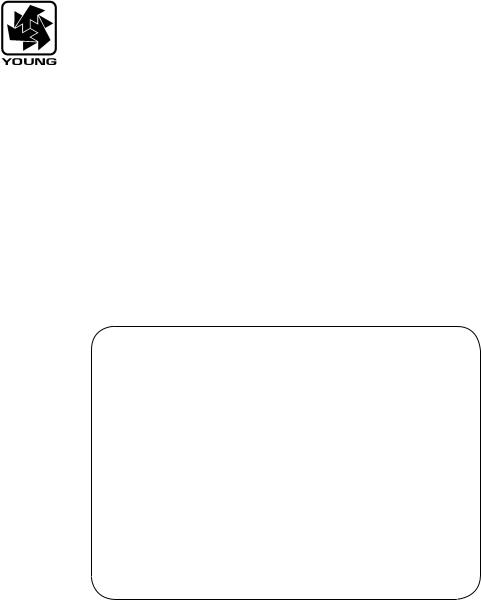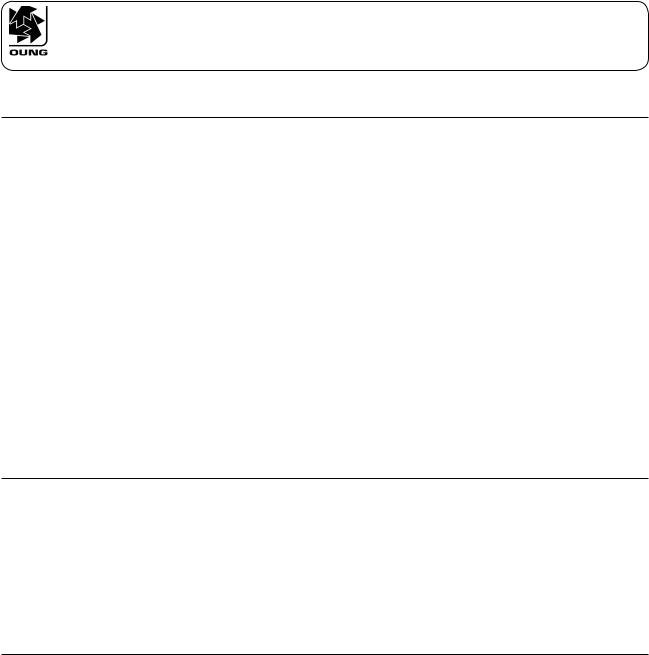Young Wind Sensor Calibration Accessories User Manual

METEOROLOGICAL INSTRUMENTS
INSTRUCTIONS
WIND SYSTEM CALIBRATION
RECOMMENDED CALIBRATION INTERVAL,
PROCEDURE, AND TEST EQUIPMENT
MODEL 18860-90
INCLUDES INSTRUCTIONS FOR THE FOLLOWING
MODEL 18802/18811 ANEMOMETER DRIVE
MODEL 18112/18212 VANE ANGLE FIXTURE
MODEL 18310/18312 TORQUE DISC
MODEL 18331 VANE TORQUE GAUGE
R.M. YOUNG COMPANY 2801 AERO PARK DRIVE, TRAVERSE CITY, MICHIGAN 49686, USA TEL: (231) 946-3980 FAX: (231) 946-4772 WEB: www.youngusa.com
P/N: 18860-90
REV: B062309

R. M. YOUNG COMPANY
WIND SYSTEM CALIBRATION
Recommended Calibration Interval, Procedure, and Test Equipment
RECOMMENDED CALIBRATION INTERVAL
|
Operational Accuracy |
Research Accuracy |
|
WS ± 0.5 m/s WD ± 5° |
WS ± 0.3 m/s WD ± 3° |
TOWER CHECK |
6 months |
3 months |
TRAILER CHECK |
12 months |
6 months |
LABORATORY CHECK |
24 months |
12 months |
MANUFACTURER CHECK |
N/A |
24 months |
OPERATIONAL ACCURACY
Manufacturer’s standard calibration is within operational accuracy limits. Perform tower check at initial installation. Tower check and trailer check intervals are recommended minimums for optimum performance.
RESEARCH ACCURACY
Sensor requires wind tunnel calibration by manufacturer, or other recognized calibration laboratory, prior to initial installation. Tower check and trailer check intervals are recommended minimums. Perform tower check at initial installation.
OUTPUT SIGNAL MEASUREMENTS
Wind speed signals vary among sensors. The signals may be frequency related for magnet/coil and photochopper transducers or voltage related for tachometer generator transducers. Wind direction signals from potentiometer transducers are voltage related and are dependent upon stable excitation voltage. To monitor wind speed and direction signals, use a suitable indicator. It may be a frequency meter, voltmeter, calibrated wind indicator, data logger with display, or some combination of these instruments. As a general rule the resolution of the indicator should be equal to the smallest unit being measured and the accuracy of the indicator should be 5 to 10 times better than that required by the calibration. If necessary quantifiy and account for any additional error introduced by the indicating device.
WIND SPEED SENSOR TYPES
The following procedures refer to a propeller type wind speed sensor, however they are equally applicable to a cup wheel type sensor. To check wind speed threshold of a cup wheel anemometer using the torque disc, hold or mount the sensor with the cup wheel shaft horizontal.
18860-90
Page 1

TOWER CHECK
Perform tower check for each initial installation regardless of prior calibration interval.
PROCEDURE |
EQUIPMENT |
|
|
Wind Speed Threshold: |
In calm weather blow gently on propeller. Watch for obvious high torque |
|
or irregular rotation. |
Wind Speed Signal: |
Remove propeller or cupwheel. Drive shaft at known rpm, representing |
|
mid range of sensor. Compare output signal to established calibration. |
Wind Direction Threshold: |
In calm weather blow gently on vane. Watch for obvious high torque or |
|
irregular motion. |
Wind Direction Signal: |
Visually align vane with known reference. Compare output signal. Align |
|
vane with additional reference points or cardinal points marked on hous- |
|
ing. Compare output signal to established calibration. |
None
Anemometer Drive
None
Survey of visible landmarks, accuratemagneticcompass,orsolar noon orientation.
TRAILER CHECK
Sensors are removed from tower and connected to signal conditioning modules with sensor cable patch cords.
|
PROCEDURE |
EQUIPMENT |
|
|
|
Wind Speed Threshold: |
Remove propeller. Set torque disc for proper torque according to table and |
Propeller Torque Disc |
|
curves supplied. Install torque disc on propeller shaft and check rotation |
|
|
of disc. See instructions on torque disc drawing. |
|
Wind Speed Signal: |
Remove propeller. Drive shaft at 200 rpm. Check output for measurable |
Anemometer Drive |
|
signal. Drive shaft at rpm representing mid range of sensor. Compare |
|
|
output signal to established calibration. |
|
Wind Direction Threshold: |
Hold or mount sensor on desk top with fin horizontal to check vane bal- |
Vane Torque Gauge |
|
ance. Adjust if required. After balancing vane assembly, mount sensor |
Vane Angle Bench Stand |
|
on bench stand on level surface. Determine proper torque according to |
|
|
table and curves supplied. Place torque gauge on vane housing and ap- |
|
|
ply steady force to end of leaf spring. Record maximum torque value for |
|
|
both CW and CCW rotation. See instructions on torque gauge drawing. |
|
|
Mount sensor on Bench Stand. Rotate fixture through 360 degrees com- |
|
Wind Direction Signal: |
paring output signal at 30 degree intervals. |
Vane Angle Bench Stand |
18860-90
Page 2

LABORATORY CHECK
Sensors and signal conditioning modules are removed from field site to calibration lab equipped with calibration fixtures and test equipment and operated by a qualified instrument technician.
|
PROCEDURE |
EQUIPMENT |
Wind Speed Threshold: |
Remove propeller. Set torque disc for proper torque according to table and |
Propeller Torque Disc |
|
curves supplied. Install torque disc on propeller shaft and check rotation. |
|
|
See instructions on torque disc drawing. |
|
Wind Speed Signal: |
Drive propeller shaft at 200 rpm, observe output on oscillioscope for |
Oscilloscope |
|
minimum signal level and proper form. Drive propeller shaft at a minimum |
Anemometer Drive |
|
of three other rpm values throughout the working range of the propeller, |
|
|
checking output signal at each speed. Compare to established calibration. |
|
Wind Direction Threshold: |
Check vane balance and adjust if required.After balancing vane assembly, |
Vane Torque Gauge |
|
mount sensor on bench stand on level surface. Determine proper torque |
Vane Angle Bench Stand |
|
according to table and curves supplied. Place torque gauge on vane |
|
|
housing and apply steady force to end of leaf spring. Record maximum |
|
|
torque value for both CW and CCW rotation. See instructions on torque |
|
|
gauge drawing. |
|
Wind Direction Signal: |
Install sensor on vane angle fixture. Check output signal at 30° intervals |
Vane Angle Fixture |
|
with additional checks at 340°, 350°, and 355°. |
|
MANUFACTURER CHECK
Return sensors to manufacturer or other recognized calibration lab. These tests are performed at manufacturer's facilities or calibration lab facilities on a fee basis.
|
PROCEDURE |
EQUIPMENT |
Wind Speed Threshold: |
Check and adjust propeller balance. Install sensor on threshold fixture. |
Threshold fixture |
|
Measure and record starting and stopping wind speed values. |
|
Wind Speed Signal: |
Install sensor in wind tunnel. Measure and record output signal at 1, 2, |
Wind tunnel facility |
|
3, 4, 5, 6, 8, 10, 12, 14, 16, 20, and 25 and 30 m/s. Tabulate wind tun- |
|
|
nel speed vs. sensor output. Calculate and record slope and intercept. |
|
Wind Direction Threshold: |
Measure vane torque and record equivalent threshold wind speed. |
Vane torque fixture |
Wind Direction Signal: |
Install sensor on master vane angle fixture. Measure and record output |
Master vane angle fixture |
|
signal through complete 360° rotation. Measure and record electrical |
|
|
function angle. |
|
18860-90
Page 3
18860-90
Page 4
